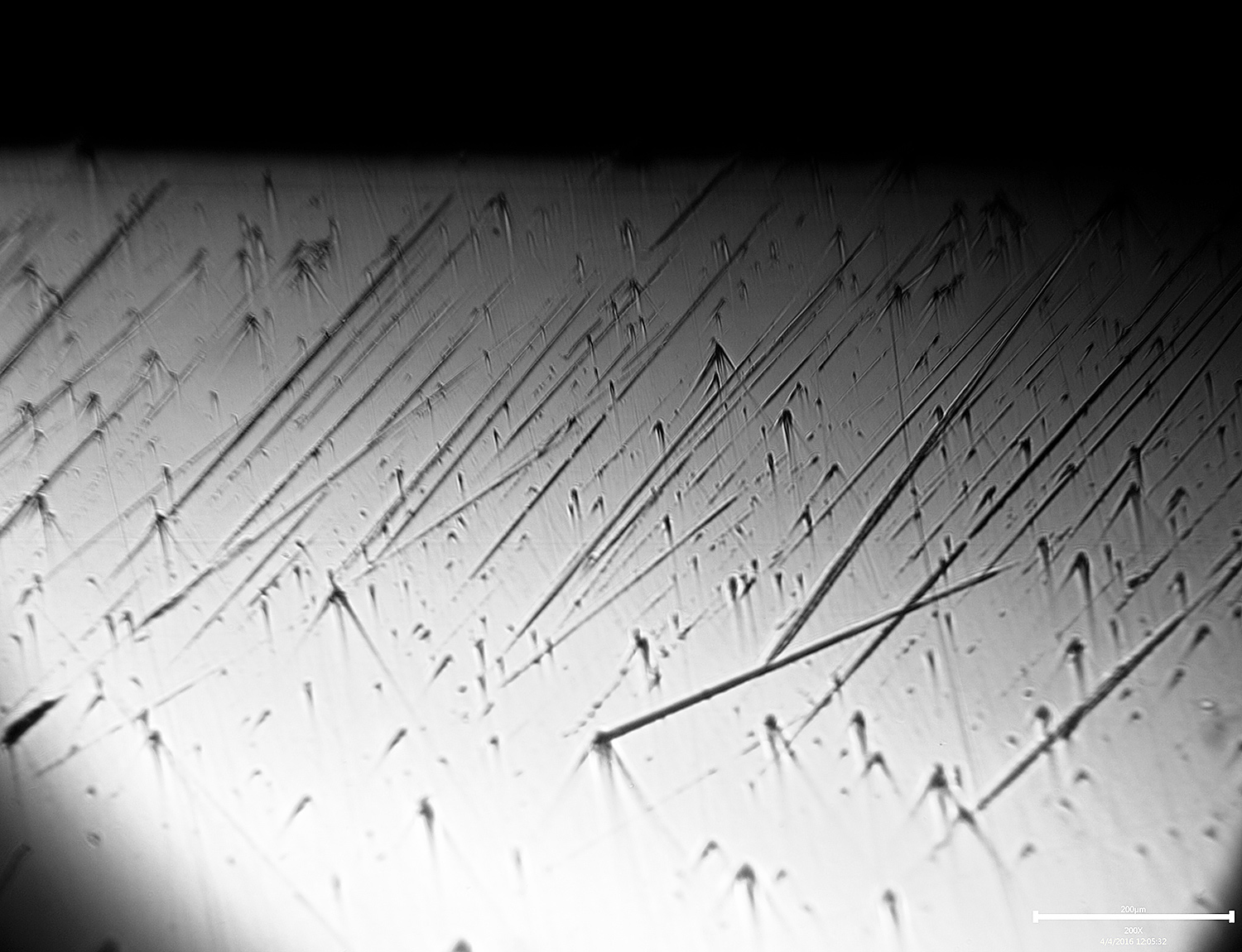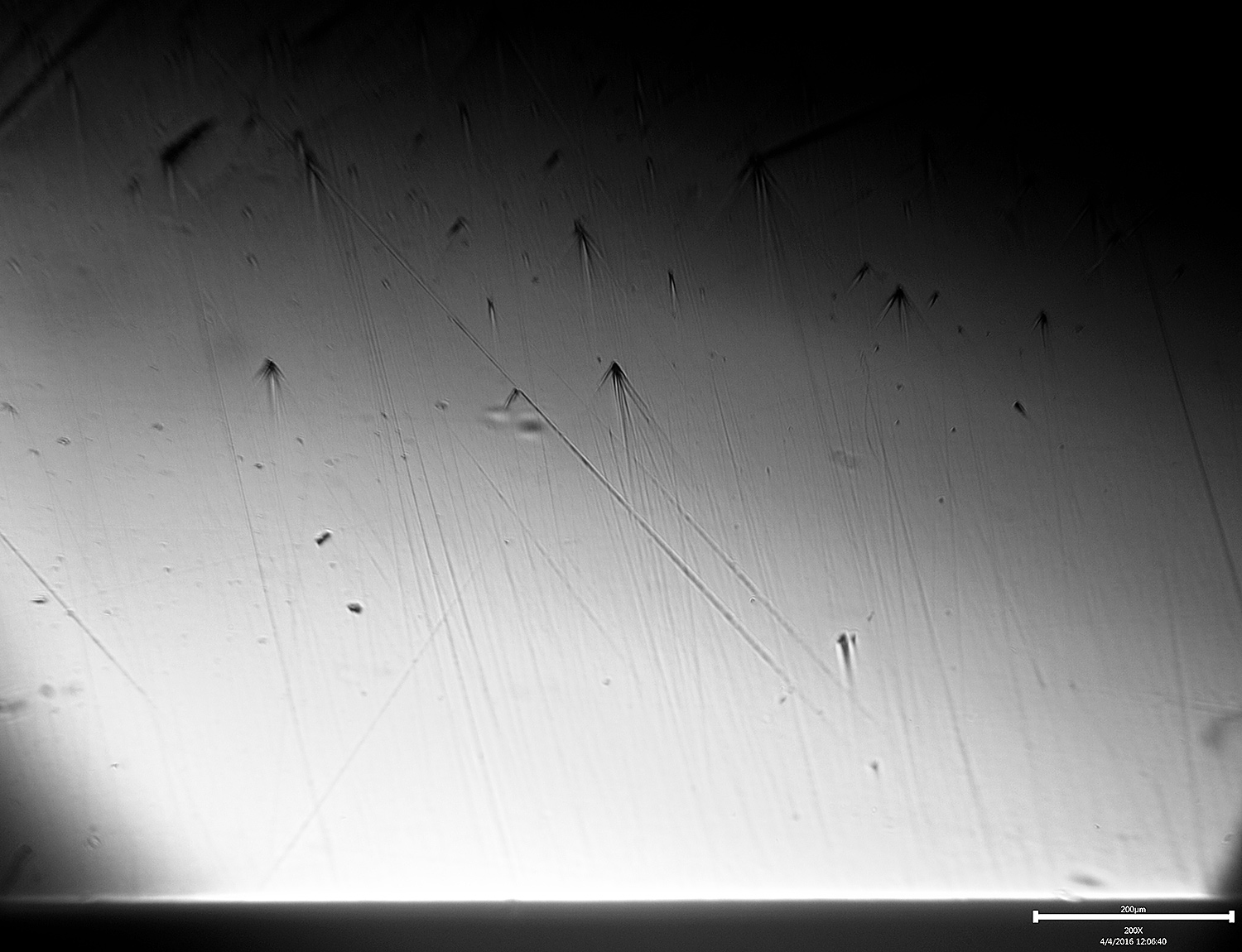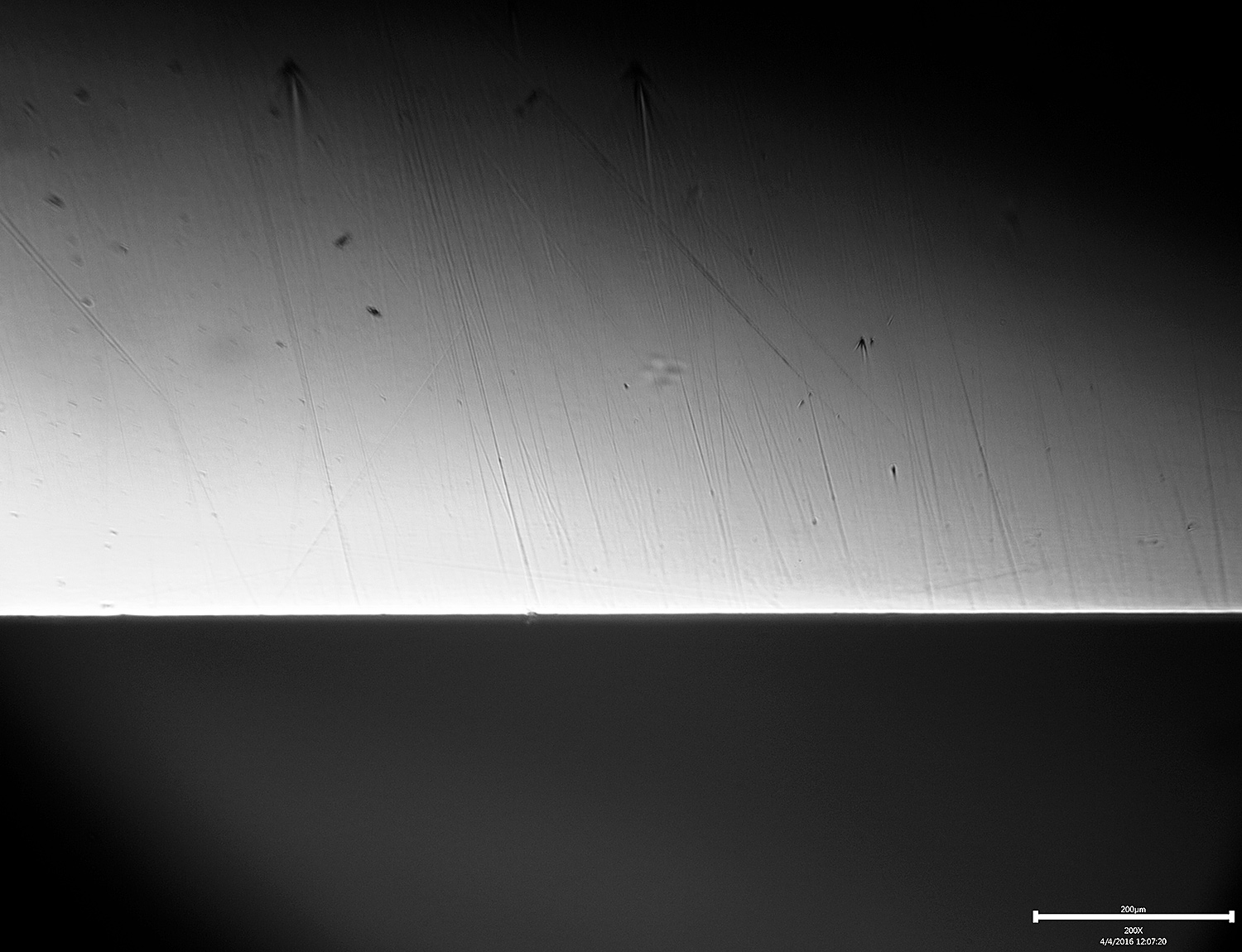Small craters and connected scratches
Recent › Forums › Main Forum › Techniques and Sharpening Strategies › Thoughts/Theories/Science Related to Sharpening › Small craters and connected scratches
- This topic has 7 replies, 4 voices, and was last updated 04/11/2016 at 5:07 pm by
Mark76.
-
AuthorPosts
-
04/11/2016 at 10:03 am #33209
Several people have asked about the little craters and connected scratches that we see sometimes in high magnification photos of very polished edges. It’s been speculated that they are little inclusions that are pulled out during the sharpening process. Based on a recent set of images, I have a new hypothesis:
They are just the remnants of old scratches that are near to being erased with just the deepest portion showing. Check out these photos:

There are scratches leaving the craters in multiple directions, reflecting the fact that I kept alternating stone/strop direction as I changed grits.
The craters and scratches are getting smaller.
And now are almost gone and show that I had moved to unidirection strokes at this point in the process.-Clay
Attachments:
You must be logged in to access attached files.
1 user thanked author for this post.
04/11/2016 at 10:34 am #33225Clay, I’m not sure I quite understand this. One of the things that baffles me sometimes is that scratches sometimes seem to “pop up” at higher levels of polishing. Could you please elaborate on your theory a bit more and what it explains?
Molecule Polishing: my blog about sharpening with the Wicked Edge
04/11/2016 at 11:18 am #33228Clay, I’m not sure I quite understand this. One of the things that baffles me sometimes is that scratches sometimes seem to “pop up” at higher levels of polishing. Could you please elaborate on your theory a bit more and what it explains?
My belief is that as scratches are polished away, the last part remaining is the deepest. It ends up looking like a little crater at the end of a scratch. As you polish further, the scratch continues to shorten where it is most shallow. Eventually you’re left with just a little pock mark and maybe a slight scratch in a tear-drop shape.
I failed to mention in the OP that I think that as a stone or strop passes over a crater, the abrasive can dig into the far side lip of the crated as it passes over, catching on the edge and creating a little scratch. I believe the scratches going in multiple directions in the photos are correlate to the alternating stroke directions I was employing. Once I switched to a single direction and continued to polish the surface, the scratches going away from the craters are aligned with my stroke direction.
-Clay
04/11/2016 at 11:27 am #33230Mark:
I’ve always attributed those scratches that “pop up” to contaminants that I’ve picked up.
Clay:
Those V-shaped scratches are really unusual. They almost look like there was some sort of inclusion which is being torn free. I wouldn’t have thought that a scratch could propagate another scratch, but maybe when two scratches intersect, there is a sudden synergy where the intersect becomes much deeper. If this were true, then I’d infer that you were using alternating direction edge-trailing strokes. Going to edge-leading should invert the V’s.
If true, then one could infer that using alternating directional strokes causes deeper scratches and would take higher numbers of strokes to achieve a final polish. Certainly not a big deal, but another interesting tidbit in our quest for the ultimate edge.
04/11/2016 at 11:52 am #33235If this were true, then I’d infer that you were using alternating direction edge-trailing strokes.
Tom,
At the point these showed up, I was using alternating, edge-trailing strokes with the strops. I believe I’d gone from a set of fairly worn 6.0µ films to some 4.0µ emulsion on leather, then to 2.0µ, 1.0µ, 0.5µ, 0.25µ and 0.1µ emulsions. I stopped alternating strokes after the 1.0µ stage.
It’s definitely made me curious. I think I can continue to study it by stopping to put the sample in the scope at shorter intervals, maybe 5-10 strokes.
-Clay
04/11/2016 at 12:16 pm #33242Cool photos, I haven’t seen these yet but I will start looking!
Eddie Kinlen
M1rror Edge Sharpening Service, LLC
+1(682)777-162204/11/2016 at 1:38 pm #33248Cool photos, I haven’t seen these yet but I will start looking!
I generally don’t see them until I get the edge highly polished and under 0.5µ.
-Clay
04/11/2016 at 5:07 pm #33258Clay, I’m not sure I quite understand this. One of the things that baffles me sometimes is that scratches sometimes seem to “pop up” at higher levels of polishing. Could you please elaborate on your theory a bit more and what it explains?
My belief is that as scratches are polished away, the last part remaining is the deepest. It ends up looking like a little crater at the end of a scratch. As you polish further, the scratch continues to shorten where it is most shallow. Eventually you’re left with just a little pock mark and maybe a slight scratch in a tear-drop shape. I failed to mention in the OP that I think that as a stone or strop passes over a crater, the abrasive can dig into the far side lip of the crated as it passes over, catching on the edge and creating a little scratch. I believe the scratches going in multiple directions in the photos are correlate to the alternating stroke directions I was employing. Once I switched to a single direction and continued to polish the surface, the scratches going away from the craters are aligned with my stroke direction.
Thanks! Now I understand.
This could very well be a good theory for explaining what happens. I’m not sure, but maybe you can test it, because the hard inclusions are torn out (in my experience – not on your pics) most often near the edge. Tom’s idea might also be a good one.
Molecule Polishing: my blog about sharpening with the Wicked Edge
-
AuthorPosts
- You must be logged in to reply to this topic.